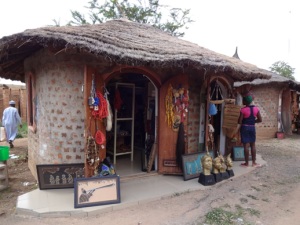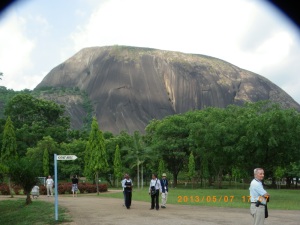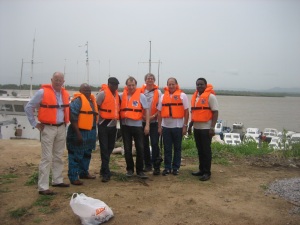|

FIG Working Week 2013 - Environment for Sustainability
Most colourful FIG Working Week with lively Nigerian flavour
Abuja, Nigeria, 6-10 May 2013
|
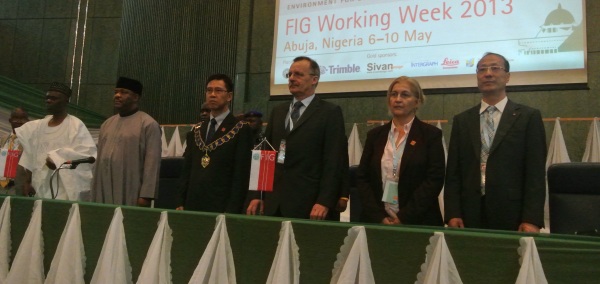
At the Opening Ceremony the Nigerian anthem and the FIG Fanfare were
played. From left:
Stephen Olubode Adeaga, President NIS, Minister of Works,
Arc. Mike Onolememen representing the Nigerian President
Goodwill Jonathan, who had sent his apologies, CheeHai Teo,
President FIG, and FIG Vice Presidents: Rudolf Staiger, Chryssy
Potsiou, and Pengfei Cheng. |
The FIG Working Week Environment for Sustainability and the
XXXVI General Assembly was held in Abuja, Nigeria from 6 to 10 May
2013.
The Working Week programme included also the Annual General Meeting
for the local host, the Nigerian Association of Surveyors (NIS). The main
partner of the Working Week was UN-HABITAT/GLTN including a
train-the-trainer workshop on STDM for Young Surveyors, four special
sessions discussing approaches to safeguard, secure, support and sustain
land rights for all which were also the Director General/Surveyor General
forum, a Joint UN-Habitat/FIG Commission 7 Session on Participatory and
Inclusive Land Readjustment (PiLAR), and a UN-Habitat GLTN Africa LPI
Capacity Development Special Event. Together with the World Bank two special
sessions on Land Administration and Reform in Sub-Saharan Africa were also
organised.
The FIG Working Week 2013 turned out to be the biggest FIG Working Week ever
if counted by number of participants. More than 2,000 Nigerians and close to
250 International participants from 40 countries attended. The Working Week
brought together participants from different cultures, diverse surveying
traditions and varying professional experiences and is the global forum for
surveyors, practitioners, land professionals and FIG partners. The technical
programme comprised of 80 technical sessions, workshops and special forums.
The total number of presented papers was almost 200 including peer-review
papers. In total 280 abstracts were submitted to the conference. The
sessions attracted full attendance, the plenary sessions were a particularly
impressive sight. The Working Week was held at the Nicon Luxury Hotel and
the International Conference Center which was next door to the hotel. The
exhibition took place at both sites and included altogether 32 exhibitors.
The social events showed the colourfulness and hospitality of the local host
starting from the welcome reception to the FIG Foundation Dinner and the
conference dinner which were impressive and lively. Also the many Surveyors
Wives gave extra flavour to the Working Week with their fantastic dresses
and cheerfulness.
|
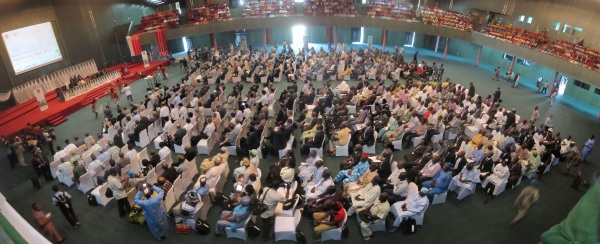
Full attendance at the opening ceremony. Photo by P. Larrakker |
Opening ceremony
On the morning of the first day of the conference, the Opening Ceremony
was held in Abuja Hall at the International Conference Center. It was an
impressive sight with the many Nigerian participants including the Nigerian
Surveyors Wives in colourful and matching dresses. The President of Nigeria,
His Excellency Dr. Goodluck Ebele Jonathan had announced his presence
for the opening, however, unfortunately urgent business caused that he could
not attend, and he was represented by Minister of Works, Arc. Mike
Onolememen.
The President of the Nigerian Institution of Surveyors, Surv. (Hon) Bode
Adeaga welcomed all the many participants who had come to the capital of
Nigeria. In his opening speech, FIG President CheeHai Teo mentioned
that “this worldwide professional community of surveyors measures,
estimates, costs, values, assesses, collects, process, models, maps,
reports, prepare contracts, plans and manages the natural and built
environment for the effective planning, efficient administration and
responsible governance of the land, the seas and its natural resources and
any structures thereon.” He continued: “FIG continues to provide the global
forum for professionals, practitioners and partners as we seek to serve the
policies, the places, and the people together. This 2013 Working Week once
again bring together participants from different cultures, from diverse
surveying traditions and varying professional experiences.”
The speech presented on behalf of the President of Nigeria, noticed that
the theme of the Working Week could not have been more appropriate. Impact
of floods and erosion are felt in Nigeria. The Minister said that surveying
is indeed the bedrock of national physical development. The contribution to
national resource management is crucial. The first Nigerian Satellite
(launched in 2003) was a breakthrough in the support to the development of
the whole region. The NigeriaSat-2 and NigeriaSat-X for earth observation
were launched in 2011 for earth observation purposes. Applications of the
collected data are in food security, petroleum indsutry, land
administration, transport, environment, planning and census.
Contribution of surveyors are in:
- security through loaction of suspicious changes in the landscape
based on imagery
- flood mapping
- wealth creation through land administration
- erosion monitoring
- coastal encroachment monitoring
- infrastructure planning, design, development and conservation
Drums and dancers from the Blackbone Theater Company took over the stage
at the opening, showing the rich cultural heritage in Nigeria. Each dance
told a story from Nigeria. The Theater Company even continued outside after
the opening ceremony.
|
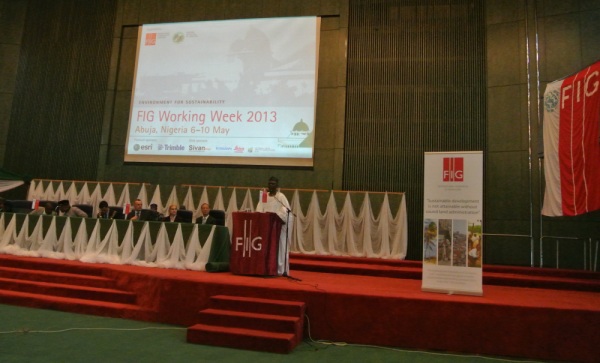
President of NIS Bode Adeaga welcoming all participants to
the FIG Working Week 2013 in Abuja, Nigeria |
|
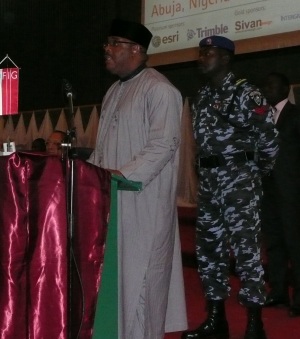
Minister of Works, Arc. Mike Onolememen presenting the speech
by the Nigerian President Goodwill Jonathan |
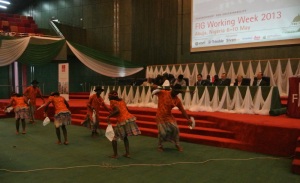
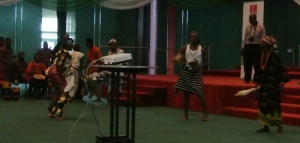
Traditional Nigerian Dancing and Drumming |
|
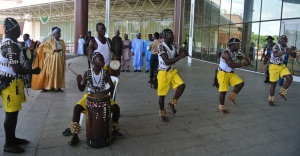
The traditional dancing and drumming continued outside after the
Opening Ceremony giving a lively atmosphere |
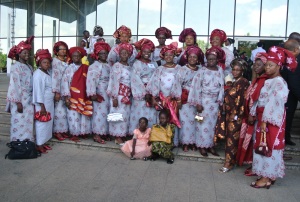
One of the Surveyors Wives groups outside the International
Conference Centre. |
Plenary Sessions
The Working Week included three well visited plenary sessions addressing
three different aspect of the conference theme on Environment for
Sustainability.
The first session addressed “Governance and Approaches”. During
his keynote, Hubert Ouedraogo (UN Economic Commission for Africa)
highlighted the engagement of the community of surveyors in the
implementation of the Land Policy Initiative (LPI). Surveyor contributions
are in innovative/cost-effective land administration with evidence-based
processes and in documenting customary-based land rights. A win-win
constellation for large-scale land-based investment needs attention. LPI is
an initiative of the African Union Commission (AUC), Economic Commission
(ECA) and the African Development Bank (AfDB). Remy Sietchiping,
Global Land Tool Network (GLTN)/UN-Habitat, held a presentation on
innovative tools and solutions to land challenges such as the Social Tenure
Domain Model (STDM)/LADM, the gender evaluation criteria, land recordation
systems, and decentralised land administration. GLTN/UN Habitat is promoting
land re-adjustment in implementation of solutions in urbanisation and slums.
Peter O. Adeniyi
gave an overview of the developments in surveying, geodesy and land
administration in Nigeria.
In the second session "Technologies and Systems", Hussein Omar
Farah, director general of the Regional Centre for Mapping of Resources
for Development in Nigeria, gave a presentation on geoinformation for
societal benefit. Peter C. Nwilo, surveyor general, Nigeria,
presented the Nigerian adaption in technology. Peter O. Large, vice
president of Trimble Navigation Ltd, presented a broad view of geospatial
technology and systems. Today, he explained, land and airborne 3D
high-precision mapping systems collect 4 billion data points per hour.
Geospatial information has evolved from paper maps to GIS to 3D virtual
models of the world, accessible to billions. GNSS infrastructure provides a
unified framework for high-precision positioning in support of agriculture
and forestry, civil engineering and infrastructure development (and BIM),
transportation and logistics and development of cadastre and geospatial data
infrastructure.
"Professional and Capacity Development" was the theme in the third
session. Jide Kufoniyi fnis, former rector of RECTAS Nigeria,
talked about capacity building. He sees very viable solutions in joint
(cross-border) education. Jean du Plessis (UN Habitat) introduced the
GLTN approach to capacity building: going beyond the technical aspect is
key, as are partnerships. The expected accomplishment on capacity
(2012-2015) is, “Strengthened capacity of partners, land actors and targeted
countries, cities and municipalities to promote and implement appropriate
land policies, tools and approaches that are pro-poor, gender appropriate,
effective and sustainable”. Frank F. K. Byamugisha, World Bank,
mentioned that documentation of all land is needed for security and for
support to investors. Forced evictions should be avoided, object
identification is relevant here – there is no need to see this as accurate
boundary surveys, he said: “We need to act with a sense of urgency. We need
to move away from surveying standards and technologies that are rigid to
flexible ones to meet today’s needs while anticipating those of tomorrow.
Relevance, and not accuracy, has to be our guiding principle. We have to
balance accuracy with speed and cost when designing spatial frameworks. And
we have to take advantage of opportunities offered by modern technology”.
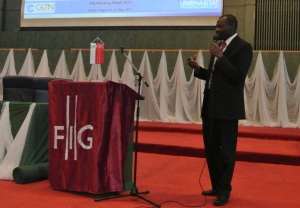
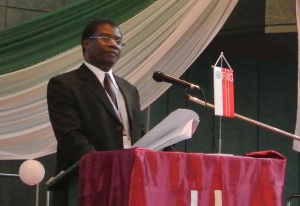
The main partners GLTN/UN-HABITAT and World Bank were both
represented by plenary speakers, from left Remy Sietchiping,
Global Land Tool Network (GLTN)/UN-Habitat and right Frank F. K.
Byamugisha, World Bank |
Technical programme
The technical programme included around 80 technical sessions, forums and
workshop. There were up to 8 parallel sessions and during the three
conference days there were nine slots for presentations. The technical
sessions included normal papers, shorter flash presentations mainly on case
studies and 24 peer reviewed papers that passed the double blind peer review
process.
The technical programme covered all FIG ten technical commissions. In
addition there were sessions organised by three task forces: FIG Africa Task
Force; Property and Housing; and Surveyors and the Climate Change. In
addition to keynote plenary presentations, there were high-level segments
and roundtables plus training-of-trainers workshops together with the FIG
partners, notably UN-Habitat, Global Land Tool Network, the African Union
Land Policy Initiative and the World Bank. The Joint UN-Habitat GLTN/FIG
Surveyor Generals Roundtable/Director Generals Forum discussed LPI, the
future for land professionals in Africa and the suite of pro-poor,
gender-responsive GLTN land tools, tools to improve transparency in land
administration, the land administration domain model and the social tenure
domain model, and costing and financing of land administration services.
This forum gathered 50 Surveyor Generals/Director Generals from all over the
world.
There was a lot of attention paid to application software and its relevance
to surveying. For example, Brent Jones from ESRI presented on
‘Cadastre 2.0 – Leveraging New Technology for Efficient, Comprehensive
Cadastral Systems’. There was also a focus on the FAO SOLA to provide
additional software functionality required for systematic registration.
The ‘Fit for Purpose Cadastre’ found attention. Nigeria has only 3% of its
land rights documented – the same or similar is valid for many countries in
sub Saharan Africa.
The World Bank and FIG held two sessions on land administration and
reform in Sub-Saharan Africa.
All the sessions were well attended and participants engaged in lively
discussions – always with a smile. We’d like to say a big thank you to our
fellow surveyors from Nigeria! It was great!
The technical tour went to AGIS,National Space Research and development
Agency.
All papers are available in the
conference proceedings. Out of the almost 300 offered papers more than
200 were accepted to the programme.
|
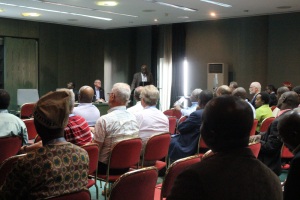
The technical sessions were well attended. |
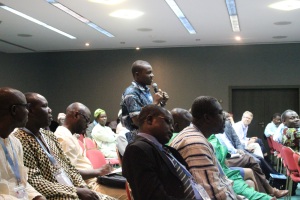
... and there were lively discussions in the sessions. |
Exhibition
The two platinum sponsors of the Working Week 2013 were Esri and Trimble
that have been the major conference partners at al FIG conferences in the
current period. Gold sponsors were Sivan Design, Integraph/Leica and the
city of Abuja. Bag sponsor was LX – Korean Cadastral Survey Corp., and pads
& pen sponsor was Thomson Reuters.
The exhibition consisted of 34 exhibitors occupying 44 booths in a mixture
of International and Nigerian companies. The exhibition took place both in
the entrance hall of the International Conference Center and at Nicon Luxury
Hotel both next to the International Registration Desk and close to the
technical session rooms in the lower floor. These locations secured a steady
flow of visitors to the show over all three days. Throughout the three days
there was a busy and inspiring atmosphere at the booths.
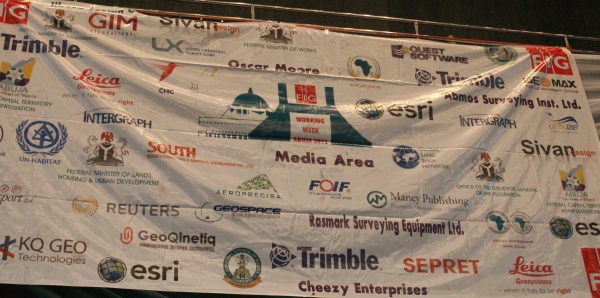
There were 34 exhibitors and sponsors at the Working Week - and a
few other selling people around the conference area. |
Social events
The Nigerian Institution of Surveyors did their utmost to create a lively
atmosphere both throughout the technical program of the Working Week and
during the social events. The days and evenings were filled with colourful
dresses and a dynamic environment. The many Nigerian participants also
contributed to the atmosphere teaching the International participants how to
celebrate the Nigerian way.
The welcome reception took place in the pool area of the Nicon Luxury Hotel.
This created a nice and relaxed atmosphere and was a good way for the
Nigerian and International participants to get acquainted. In real Nigerian
style there was lively music and it was difficult not to be inspired by the
rythms.
The Fig Foundation dinner/cultural evening was held at the International
Conference Center in the Africa Hall, which was astonishingly changed from
the plenary session hall to a festive dinner setting. The President of FIG
Foundation, John Hohol, welcomed all to the dinner and Keith
Hofgartner spoke on behalf of Trimble who was main sponsor of the
Foundation dinner. During the evening drummers and dancers entertained in
amazing Nigerian traditional dances.
The gala dinner was also held at the Africa Hall in the International
Conference Center. The dinner took place after the Annual General Meeting of
the Nigerian Institution of Surveyors and was therefore also their
traditional dinner including thanks to all involved in the Working Week. The
Minister of Works, Arc. Mike Onolememen, participated in the dinner.
During the dinner a local duo entertained with funny stories and
reflections. Again there was time for dancing which this time were the most
amazing and acrobatic dancers performing the most excellent acrobatic
exercises. The International participants were asked to perform their
dancing which created much fun and laughs. A Nigerian band took care of the
musical entertainment the rest of the evening.
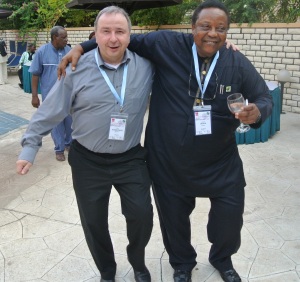
Getting acquainted at the welcome reception in the pool area of the
Nicon Luxury Hotel. |
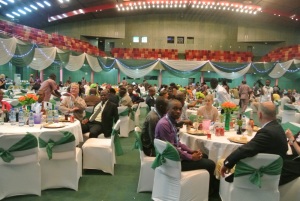
At the Foundation dinner/Nigerian evening there was a lively
atmosphere. An amazing dance and drum show was performed during the
evening. |
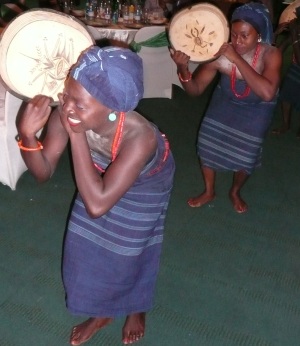
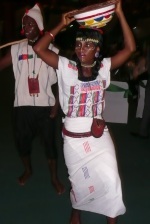
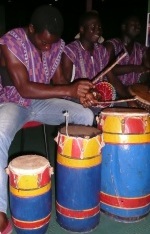 |
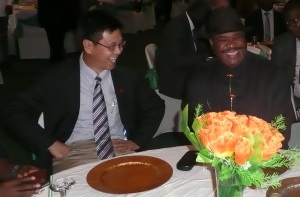
FIG President CheeHai Teo and Minister of Works, Arc. Mike
Onolememen enjoy the gala dinner |
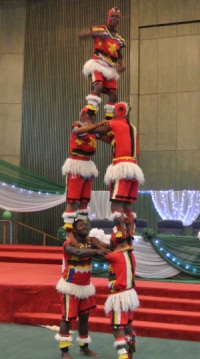
The most amazing dancers and acrobats performed at the gala dinner |
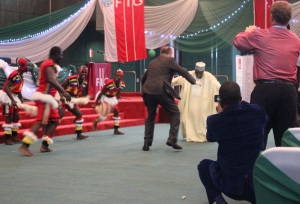
Vice President Rudolfs Staiger showing his African dance
talent together with NIS president Bode Adeaga and the
Nigerian dancers. |
Social tours
A social tour during the Working Week was offered and a post trip. The
social trip went to the Abuja Arts and Craft Village - a center for arts and
crafts, located in the Central Business District, behind the Silverbird
Cinema. Hereafter the Aso Rock located on the outskirts of Abuja was
visited, a large (400 m) monolith. It is the most noticeable feature in the
city. "Aso" means victorious in the native language of the (now displaced)
Asokoro ("the people of victory"). Around the outcrop Nigerian Presidential
Complex, Nigerian National Assembly, and Nigerian Supreme Court are located.
Hereafter the trip went to Abuja Zoo in the Asokoro District of Abuja, near
Aso Rock. Hereafter past the The Three Arms Zone – district where the
Presidential Villa, the National Assembly and the Supreme Court are located
and the Independence Avenue (from Three Arm Zone to Abuja Stadium) and some
buildings located along (or near) the avenue: NNPC Towers; CBN headquarters
(image 1); National Mosque Abuja; National Christian Centre, Nigerian
Communications Commission, and many governmental and business buildings like
Millennium Tower (under construction). At last the participants visited the
Handcraft Village located near the Stadium.
The post-conference technical tour took place to the Confluence (meeting
point) of the two main rivers of Nigeria, the Niger and the Benue.
Participants enjoyed the trip from Abuja to Lokoja through the beautiful
landscape, about 200 km southwards, where the rivers meet. After an
explanation by the Inland Water Authority on the spot, participants embarked
on one of the hydrographic boats, to experience the confluence directly from
the water. A short visit was brought to a little monument and church at the
shore, where Anglican bishop Samuel Ajayi Crowther performed his first
baptise, in 1862.
Conclusion
The General Assembly and its decisions are described in a
separate report.
The Working Week ended with a closing ceremony after the second General
Assembly. In his
summary presentation President Teo highlighted some of the important
messages throughout the Working Week. He ended concluding that there is a
need for surveyors in the continuous work to develop and secure land.
At the closing ceremony President Teo acknowledged for the successful
Working Week the local organising committee, especially Bode Adeaga,
President of NIS, Congress Director Barde Jatau, VP for
International affairs Gene Amako, Secretary General of NIS Olumide
Adewebi, Admin. Secretary of NIS and Conference Coordinator of FIG 2013
Olatunde O. Adejanyu, as well as other members of the organising
committee and officials. They did a very great job to secure this
unforgettable Working Week 2013.
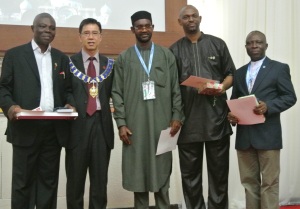
A special thanks to the steering group: Bode Adeaga,
President of NIS, VP for International affairs Gene Amako,
Secretary General of NIS Olumide Adewebi, Admin.
Secretary of NIS and Conference Coordinator of FIG 2013 Olatunde
O. Adejanyu, as well as other members of the organising
committee and officials. Congress Director Barde Jatau was
not present. |
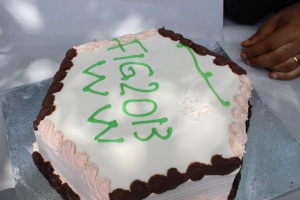
Special thanks to the local organisers who had made an enormous
effort to make the Working Week 2013 a very memorable event. |
More to Read:
Links to documents and reports of the FIG Working Week 2013
and the XXXVI General Assembly in Abuja, Nigeria:

 |













































